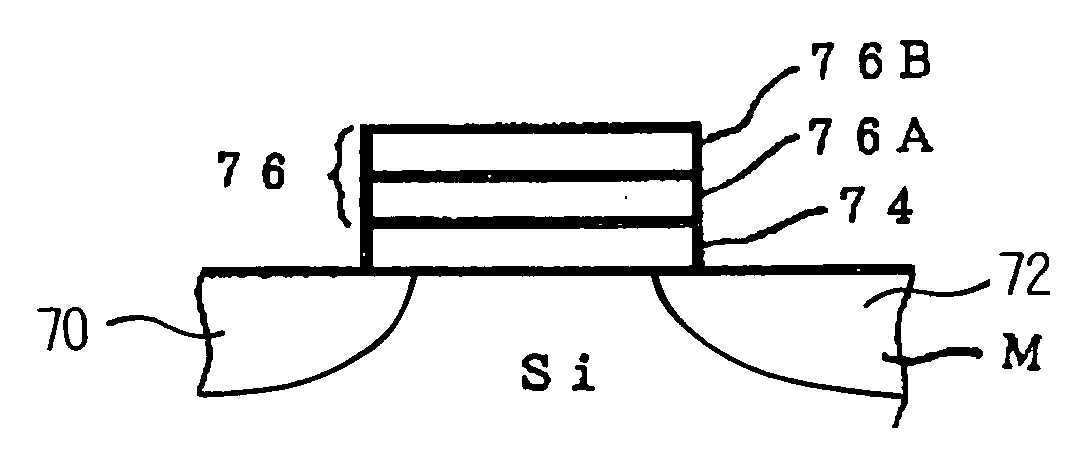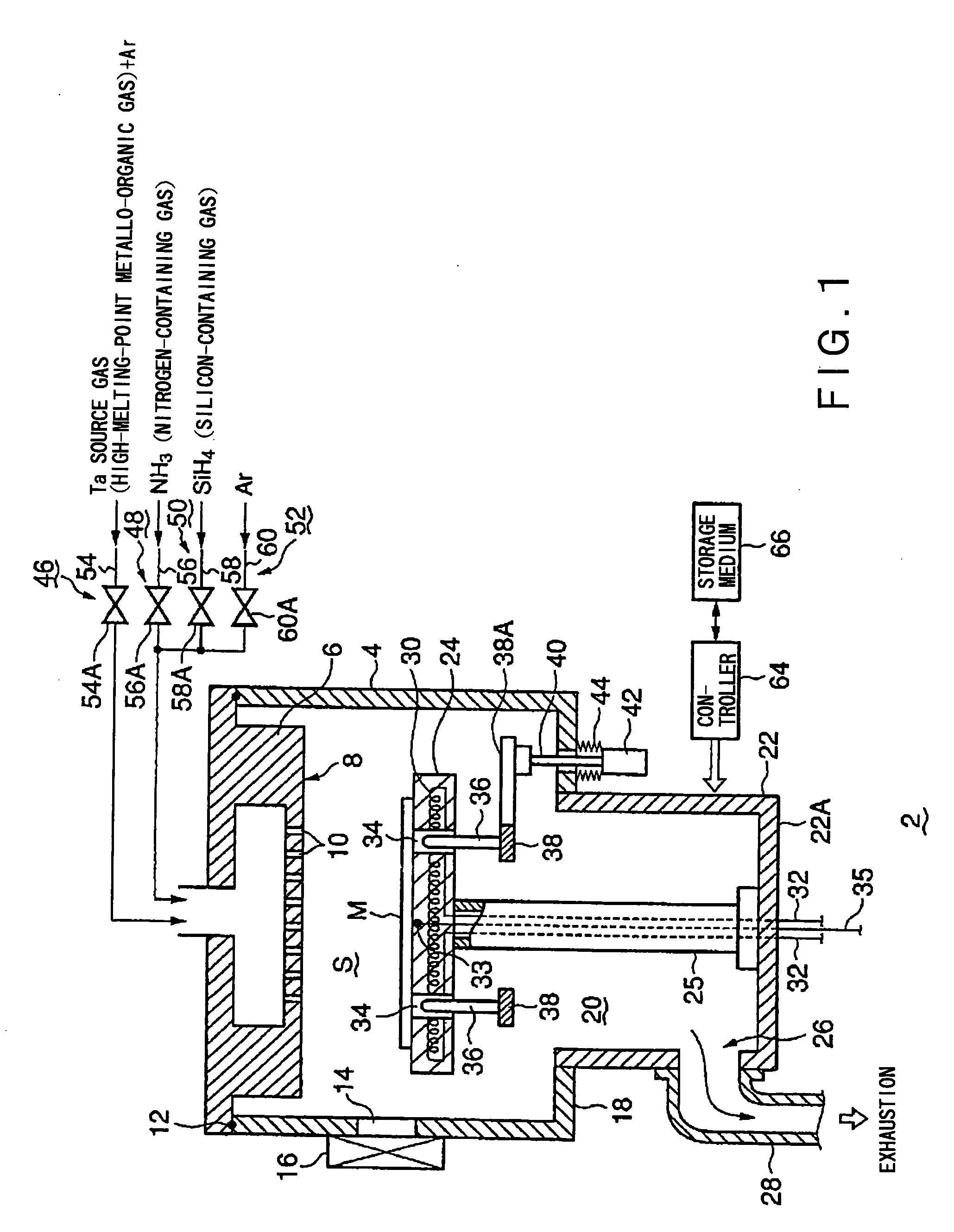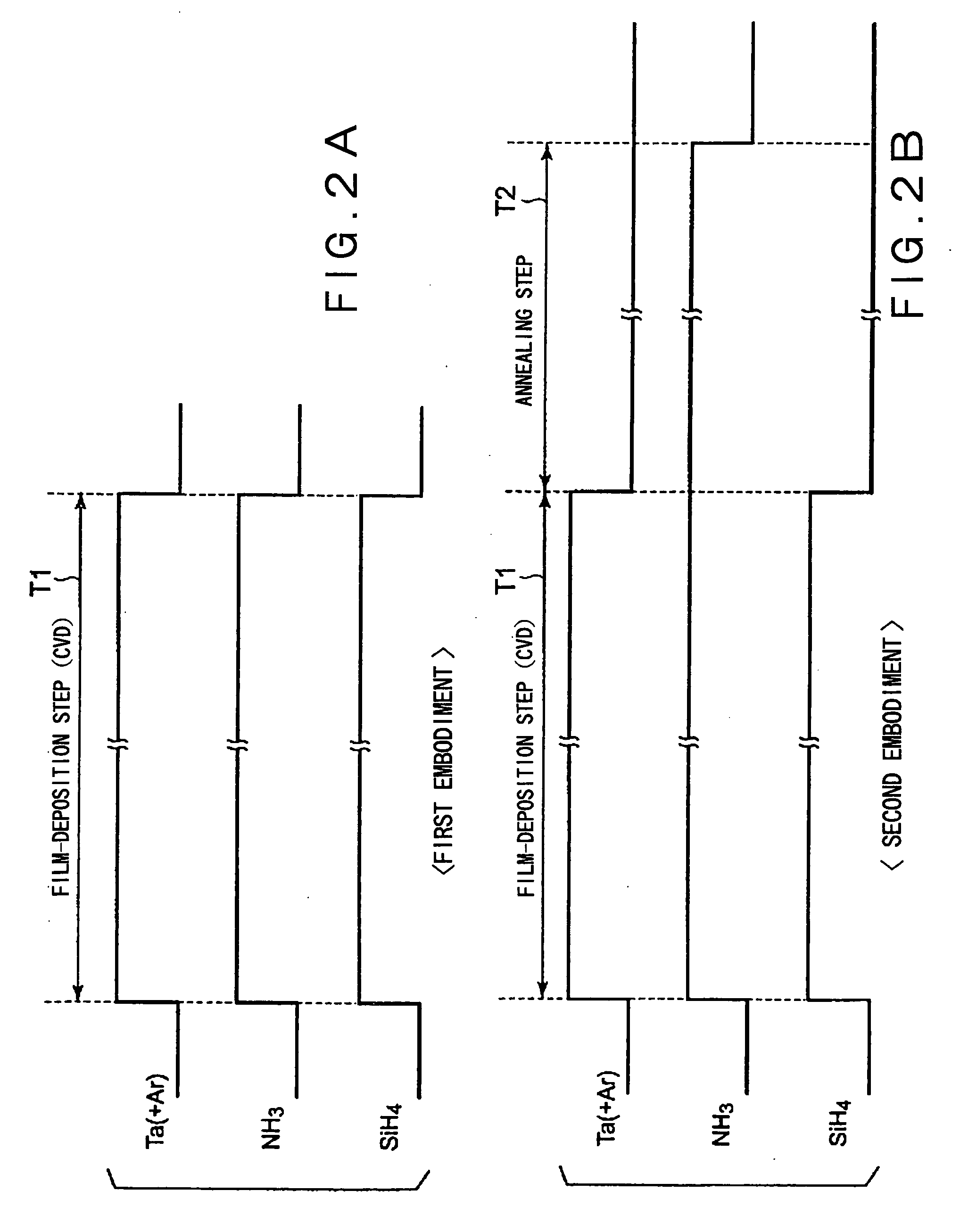Method of Film Deposition and Film Deposition System
a film deposition and film technology, applied in the field of film deposition and film deposition systems, can solve the problems of difficult to find out some materials having such a low work function and strict design rules, and achieve the effect of lowering the threshold value of the gate electrode and low work function
- Summary
- Abstract
- Description
- Claims
- Application Information
AI Technical Summary
Benefits of technology
Problems solved by technology
Method used
Image
Examples
first embodiment
[0072]The first embodiment of the method of film deposition according to the present invention will be described.
[0073]FIG. 2A is a diagram showing a gas supply mode in the first embodiment of the method of the invention. FIG. 9A shows the major film-deposition conditions and the analysis result of the formed thin film. As described above, herein, as a thin film of a metallic compound, a silicon tantalum nitride film containing carbon (TaSiN containing C) is formed.
[0074]As shown in FIG. 2A, a Ta source gas (herein, Taimato), an NH3 gas and a monosilane gas (SiH4) are simultaneously supplied into the processing vessel 4, and a film-deposition process is conducted by a CVD process for a predetermined time (film-deposition time) T1.
[0075]Thus, a TaSiN film containing C is formed. The process conditions are explained as follows. The process temperature is preferably within a range of 300 to 700° C., for example being set at 600° C. The process pressure is preferably within a range of 5...
second embodiment
[0077]The second embodiment of the method of film deposition according to the present invention will be described.
[0078]FIG. 2B is a diagram showing a gas supply mode in the second embodiment of the method of the invention. FIG. 9A shows the major film-deposition conditions and the analysis result of the formed thin film.
[0079]As shown in FIG. 2B, in the second embodiment, an annealing process is conducted to the thin film, which has been formed according to the first embodiment, under an in-situ situation without exposing the wafer M to the atmospheric air. For example, after the film-deposition process, the annealing process (annealing step) is conducted in the same processing vessel 4 without taking out the wafer M from the processing vessel 4. More concretely, after the completion of the film-deposition step, the supply of the Ta source gas and of the SiH4 gas is stopped, but the supply of the NH3 gas is continued, so that the annealing process is conducted for a predetermined t...
third embodiment
[0089]The third embodiment of the method of film deposition according to the present invention will be described.
[0090]FIG. 4A is a diagram showing a gas supply mode in the third embodiment of the method of the invention. FIG. 9A shows the major film-deposition conditions and the analysis result of the formed thin film.
[0091]In the first embodiment and the second embodiment, during the film-deposition process, the NH3 gas and the SiH4 gas are supplied. However, in the third embodiment, the supply of the both gases is stopped, and only the Ta source gas is supplied. That is, as shown in FIG. 4A, the Ta source gas is supplied together with the Ar carrier gas, and a thin film is deposited for a predetermined time T3 by means of a CVD process. The thin film doesn't contain Si, but organic components of the Ta source gas are dissociated, so that a TaN film containing C is formed as the thin film (see the third embodiment in FIG. 9A).
[0092]The process conditions are explained as follows. ...
PUM
| Property | Measurement | Unit |
|---|---|---|
| Work Function | aaaaa | aaaaa |
| work function | aaaaa | aaaaa |
| work function | aaaaa | aaaaa |
Abstract
Description
Claims
Application Information
 Login to View More
Login to View More - R&D
- Intellectual Property
- Life Sciences
- Materials
- Tech Scout
- Unparalleled Data Quality
- Higher Quality Content
- 60% Fewer Hallucinations
Browse by: Latest US Patents, China's latest patents, Technical Efficacy Thesaurus, Application Domain, Technology Topic, Popular Technical Reports.
© 2025 PatSnap. All rights reserved.Legal|Privacy policy|Modern Slavery Act Transparency Statement|Sitemap|About US| Contact US: help@patsnap.com



